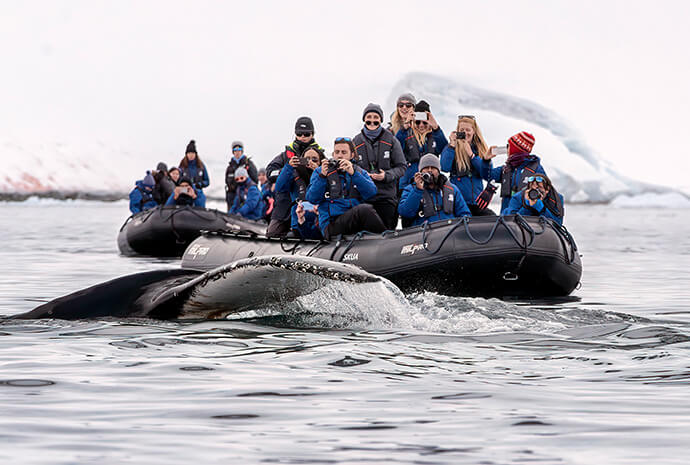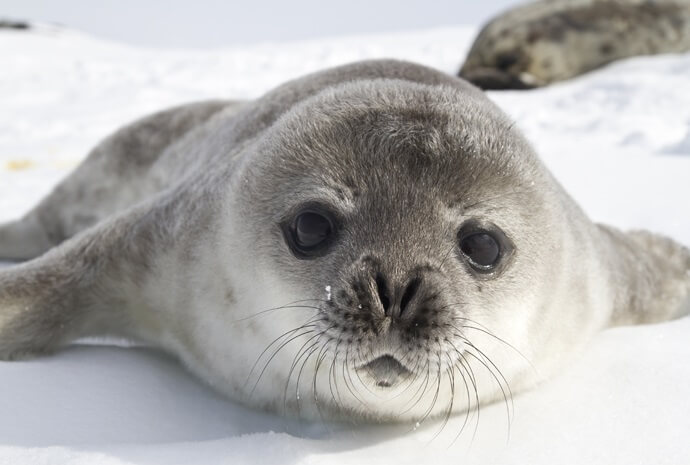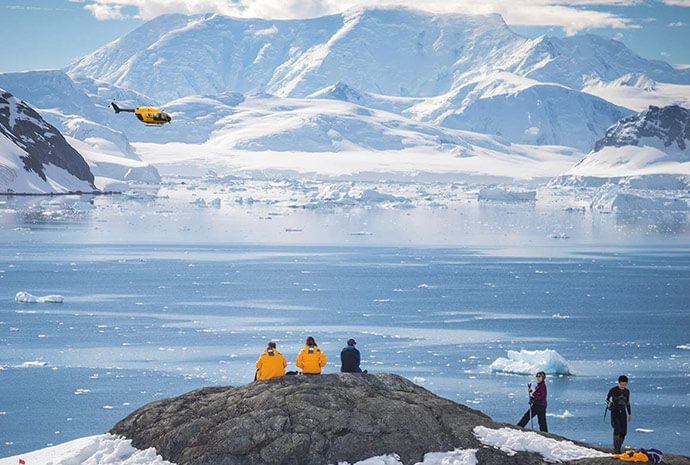
Antarctica Bird Expeditions
See some of the most fantastic birds in the world
There are 46 species of birds in Antarctica, including Albatrosses, Shearwaters and Petrels, Storm-Petrels, Diving petrels, Cormorants, Bitterns, Herons and Egrets, Ducks, Geese and Swans, Sheathbills, Skuas and Jaegers, Gulls, Terns; these too have waterproof feathers on top of downy insulating feathers. However, probably the best known species is the penguin. The penguins that live on the Antarctic Peninsula have an extremely short breeding season which means that between the time they come ashore, build a nest, lay an egg, hatch a chick and head back to sea for the winter is only about 4 months.
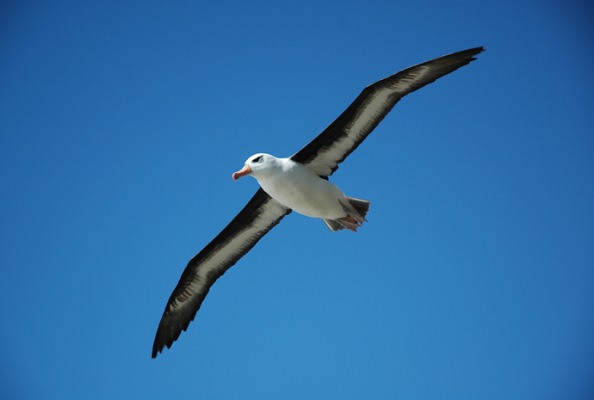
Penguins
Penguins are the most common birds of Antarctica, living in colonies with populations larger than some cities, and surviving in the harshest of conditions. However, of the 17 different species of penguin, only two (emperor and Adélie) are true Antarctic birds, although others (chinstrap, gentoo and macaroni) breed on the northern tip of the Antarctic Peninsula, where conditions are less harsh. King penguins only breed on the warmer more northerly sub-Antarctic islands.
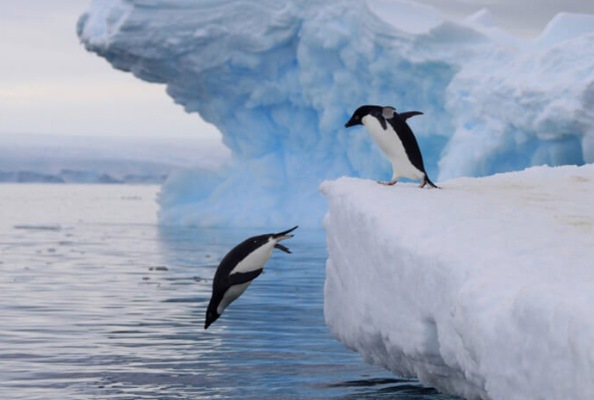
WILDFOOT Wildlife & Adventure Specialist
Lines are open from 9am -5.30pm
Monday - Friday

Amy Lucas
Senior Travel Expert
Adelie (Pygoscelis adeliae)
Adélies are truly Antarctic penguins, restricted to Antarctic coastal waters. During winter they spend their time in the pack ice, then in the summer they move south, back to the Antarctic coast.
Closely packed Adélie rookeries of many thousands of pairs are found all around the Antarctic continent, on ice-free slopes and islands, often far from open water. Fishing mainly for krill, they can dive up to 175m, but mainly catch their food at the surface.
They experience the briefest of breeding seasons in the harshest conditions. The males arrive at the breeding ground first, walking many miles over sea-ice.
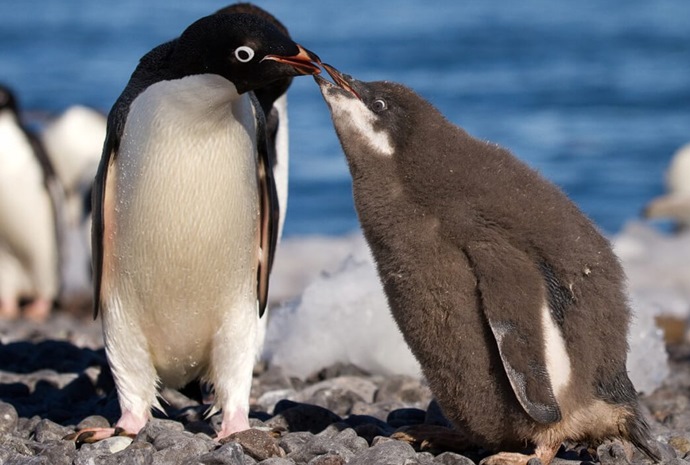
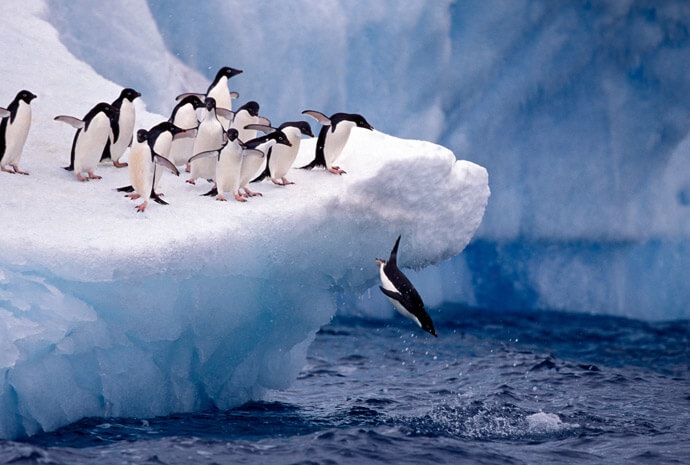
When the females arrive a few days later, a brief courtship of flipper-waving and calling follows - but they must hurry, with such short summers, they don't have much time.
Two eggs are laid in mid-November, tended by both parents, which hatch in late December. The chicks join a crèche at three weeks, and by mid-February they are at sea.
Adélies are very vulnerable until they reach the crèche stage, and less than two-thirds of them make it this far. Once at sea they are fairly safe, and can live more than 16 years. Though they have the highest mortality for juveniles and adults of any penguins species, they are a successful species, with two and a half million pairs
Chinstrap (Pygoscelis antarctica)
Named after the black band of feathers under their chin, chinstrap penguins are probably the most abundant of Antarctic birds, with an estimated population of nearly eight million pairs, concentrated on the Antarctic Peninsula.
Living mainly on a diet of crustaceans (they can dive up to 70m but catch most of their food in half-minute dives in the top 10m of the sea), chinstraps stick close to their breeding grounds. Unusually, they often dive at night.
They nest on ice-free slopes with thousands of breeding pairs, sometimes with their closest relatives, Adélie and gentoo penguins.
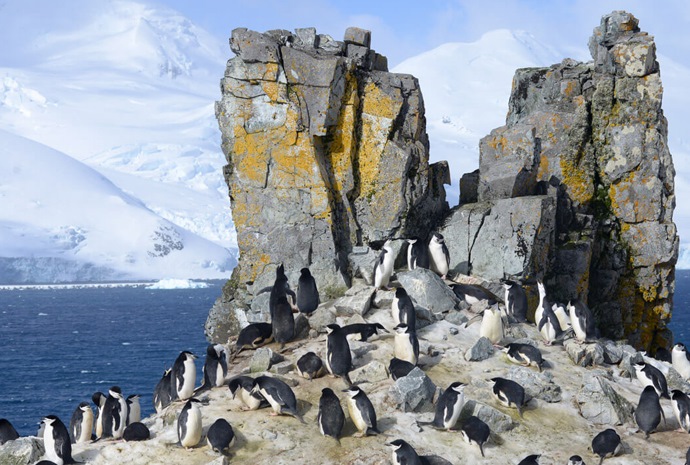
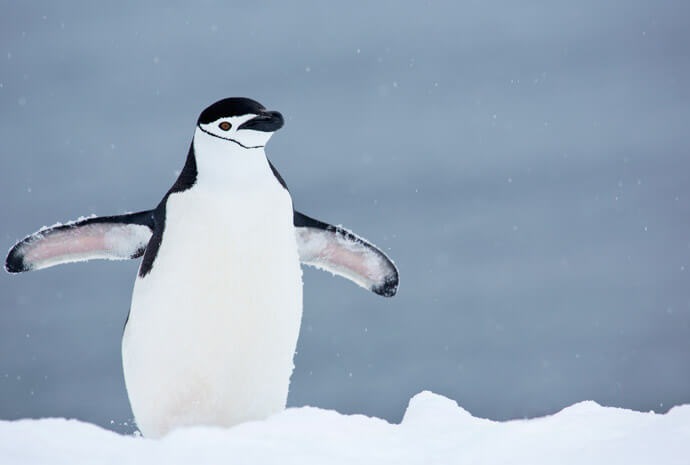
The highest slopes are the most popular (they become ice-free first) and they use their beak and claws to reach seemingly improbable spots.
They form a strong pair bond, returning each year to the same nest site with the same partner. Because of their warmer breeding location, chinstraps enjoy a longer breeding season than the Adélie.
The eggs are laid late in November and hatch in early January, and the chicks have usually fledged two months later. The two chicks are treated equally by the parents, but breeding success is severely reduced if the sea-ice does not break away from near their colonies.
Emperor (Aptenodytes forsteri)
The emperor is the giant of the penguin world and the most iconic of the birds of Antarctica. Gold patches on their ears and on the top of their chest brighten up their black heads. Emperors and their closest relative, the king penguin, have unique breeding cycles, with very long chick-rearing periods. The emperor penguins breed the furthest south of any penguin species, forming large colonies on the sea-ice surrounding the Antarctic continent. They are true Antarctic birds, rarely seen in the subantarctic waters.
So that the chicks can fledge in the late summer season, emperors breed during the cold, dark winter, with temperatures as low at -50°C and winds up to 200km per hour. They trek 50–120 km (30–75 mls) over the ice to breeding colonies which may include thousands of individuals. The female lays a single egg in May then passes it over to her mate to incubate whilst she goes to sea to feed. For nine weeks the male fasts, losing 45% of his body weight.
The male balances the egg on his feet, which are covered in a thick roll of skin and feathers. The egg can be 70°C warmer than the outside temperature.
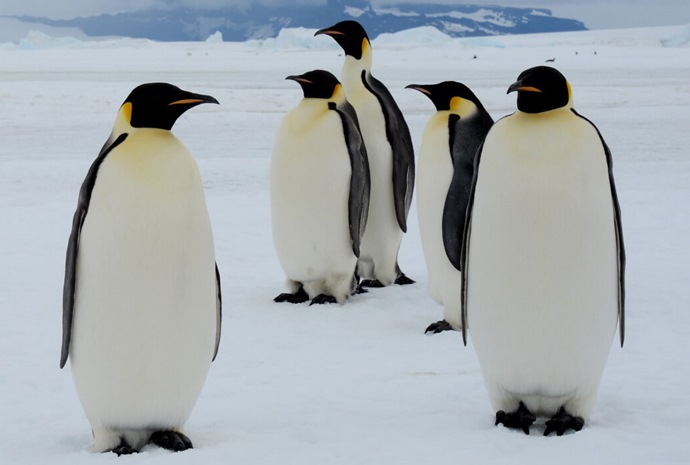
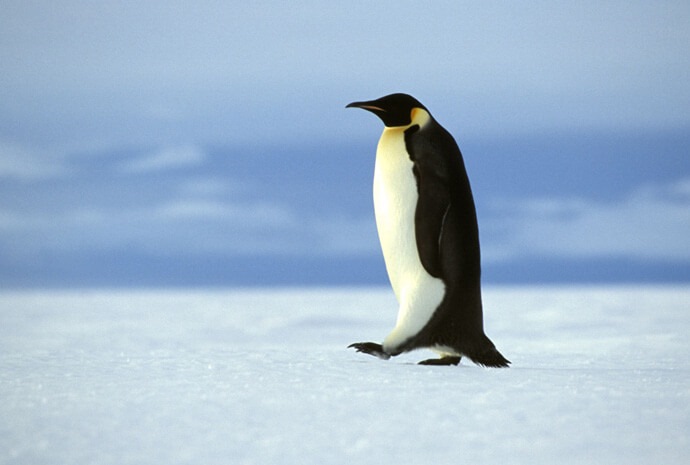
To achieve this amazing preservation of heat, emperors have a special combination of adaptations, with a dense double layer of feathers and a large fat reserve. They also cast aside the aggression of other species, with up to 5,000 adults and chicks huddling together for warmth, shuffling round so each gets a turn on the outside. To prevent heat loss, emperor penguins have proportionally smaller beaks and flippers compared to other penguins.
When the female arrives back in August, just around the time when the chicks are due to hatch, she takes over feeding the chick whilst the male treks up to frozen sea.
When the sea-ice begins to break out in December/January the chicks are shedding their soft down, but still go to sea, weighing only 60% of adult weight, the lowest value for any penguin. It is thought that emperors evolved this unusual winter breeding to allow the chick to be independent at a time when food is most plentiful. They can breed when they are three years old, but many will not start until they are six. The lifespan is typically 20 years in the wild, although some individuals may live to 50 years of age.
Gentoo (Pygoscelis papua)
Gentoo penguins have the most prominent tail of all penguins, which sticks out behind and sweeps from side to side as they walk.
They have white patches extending from their eyes and a bright red-orange beak. They are one of the least numerous Antarctic penguins, with about 300,000 breeding pairs.
Gentoo penguins are less likely to stick together than other penguins and can be found in small groups, sometimes with other species. Although they are not strongly attached to the same nest site (they have plenty of choice of sites) their pair-bonding is strong, and they usually mate with the same partner as the previous year.
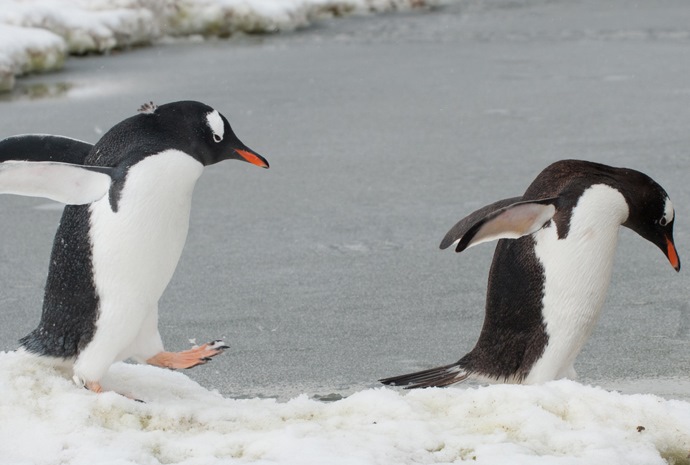
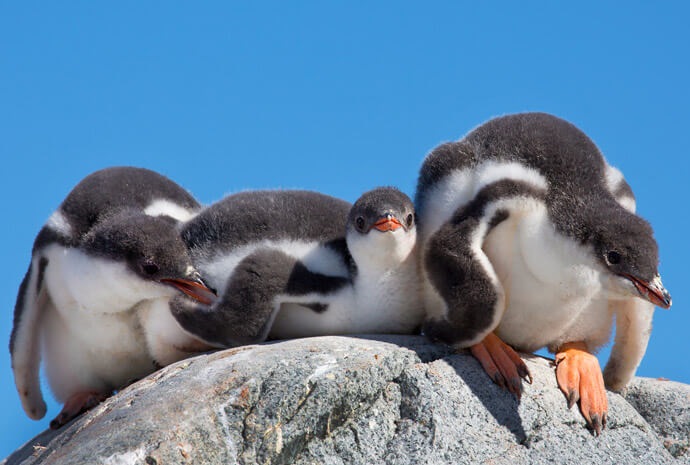
They nest on low hilltops or open beaches. When available, they make a nest with pebbles and other objects, and sometimes use a scrape in the ground - but all nests are fiercely defended. Two eggs are laid. In southern locations the first and second-born chicks are equally likely to survive, but the second gentoo chick to hatch in more northerly islands usually dies. If both chicks die, breeding may take place again. Once hatched, the chicks join the crèche about a month later.
There are large differences in gentoo penguins from different locations. Fledging is far quicker in the south (62-82 days) than in the north (85-117 days) and gentoos from the south are smaller than their northerly relatives. Unusually for penguins, their breeding times are not well synchronised and their breeding success fluctuates greatly from year to year.
King (Aptenodytes patagonicus)
King penguins are the second largest penguins, with a striking patch of orange-gold feathers on their neck. They are expert divers, reaching depths of greater than 240m, but walk slowly and deliberately on land.
Unlike their closest relative, the emperor penguin, kings, although classed as Antarctic birds, prefer warmer temperatures and live in vegetated regions of the sub-Antarctic, meaning that they do not have to put up with the temperature extremes of the Antarctic continent. However, they too have highly unusual breeding cycles. A single egg is laid any time from November to April and incubated on the feet. Both parents share the parenting as open water is always close by. It can take 10 to 13 months to fledge a chick.
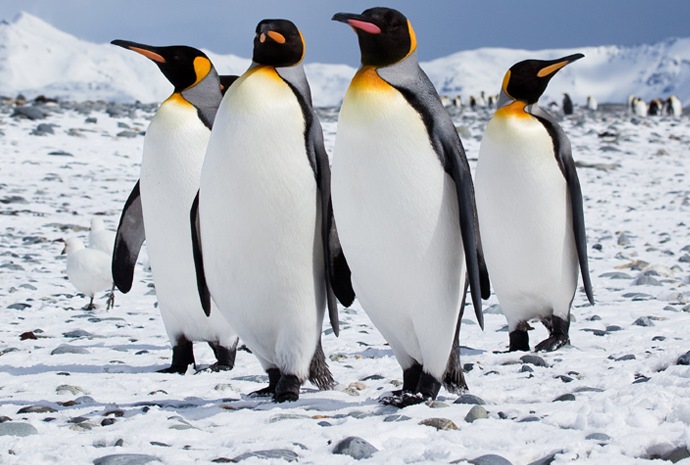
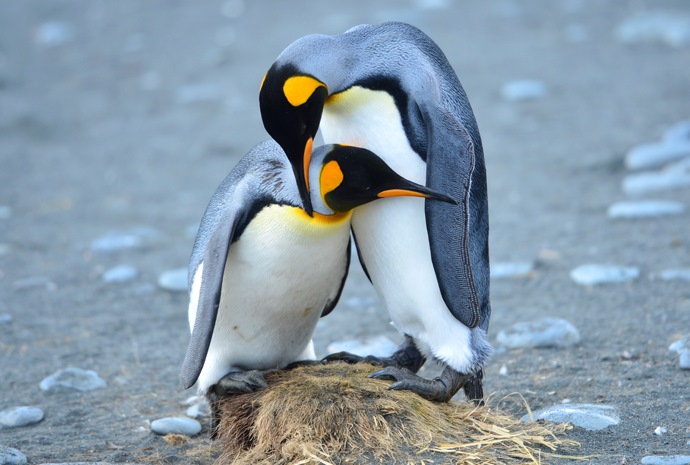
Because of this long chick-rearing period, king penguins only produce two chicks every three years. When six weeks old, the chick joins a crèche whilst its parents go fishing. In a king penguin colony there may be 12-month-old chicks around whilst other birds are incubating eggs.
They live in colonies of varying sizes, from 30 birds to tens of thousands. In the 19th and 20th centuries, populations were reduced through exploitation for their oil, flesh, eggs and skins - populations are now thought to be expanding and there are estimated to be over one million breeding pairs.
Macaroni (Eudyptes chrysolophus)
Named after the bizarre “Macaroni coiffure” hairstyles of 18th century dandies, macaroni penguins have orange tufty plumes for eyebrows.
With an estimated population of 12 million breeding pairs, macaroni penguins are the most numerous penguins, but only a proportion of them live in the Antarctic region where they inhabit sub-Antarctic islands (although there is one macaroni rookery on the Antarctic Peninsula).
Macaronis are very colonial, forming massive colonies of hundreds of thousands of birds, nesting on hillsides and rocky cliffs.
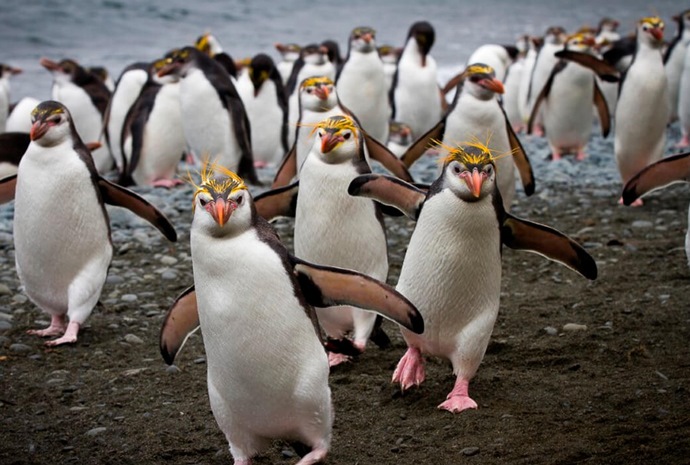
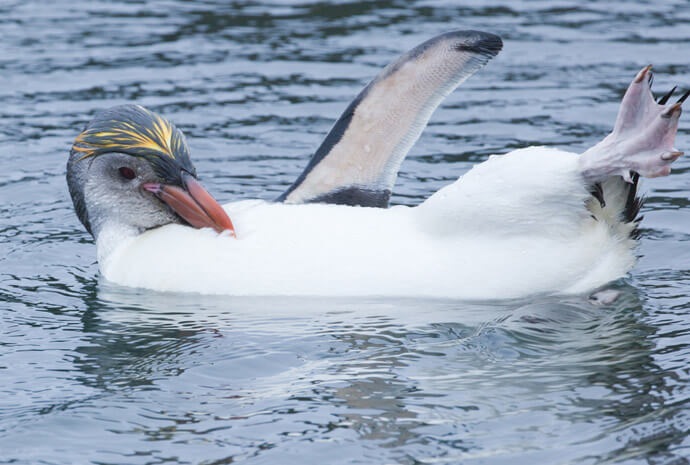
They are very vocal, especially when establishing territories. Like other crested penguins, the macaroni has a curious egg-laying habit. Two eggs are laid, the first much smaller than the second. The small egg.
On the island of South Georgia they arrive at their breeding grounds in late October and lay their eggs about two weeks later. Long incubation shifts are shared between both parents, who can lose up to half of their body weight. The chick fledges two months after hatching. Only one third of the breeding pairs raise a chick to fledge, but this success rate is very stable. The macaroni does not experience the boom and bust cycles of other penguins, possibly because they concentrate their efforts on just one chick.
Rockhopper (Eudyptes chrysocome)
Rockhopper penguins are distinguished by the crest of spiky yellow and black feathers that adorns their head and, with their wide distribution, are one of the most distinctive birds of Antarctica.
Biologists left little ambiguity about this species’ preferred habitat when assigning its eponymous name. Rockhoppers are found bounding—rather than waddling, as most other penguins do—among the craggy, windswept shorelines of the islands north of Antarctica, from Chile to New Zealand.
These gregarious marine birds are among the world's smallest penguins, standing about 20 inches (50 centimeters) tall. They have blood-red eyes, a red-orange beak, and pink webbed feet.During annual breeding times, rockhoppers gather in vast, noisy colonies, often numbering in the hundreds of thousands, to construct burrows in the tall tussock grasses near shore.
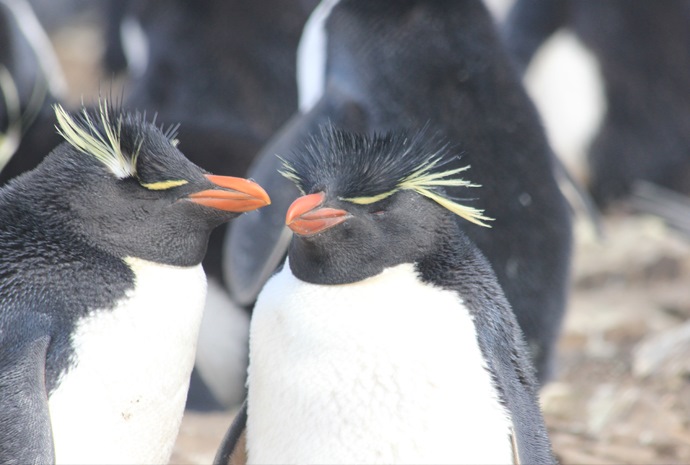
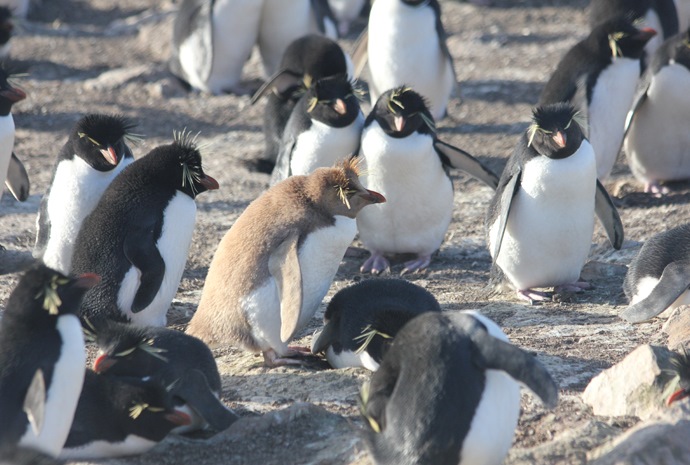
They return to the same breeding ground, and often to the same nest, each year, and usually seek out their previous year's mate.Both parents take turns incubating the eggs, aggressively pecking at anything, big or small, that may stray too close.Rockhoppers ply the frigid waters of their range using strong, narrow, flipper-like wings for propulsion. They usually stick to the shallows, but are capable of diving up to 330 feet (100 meters) in pursuit of fish, crustaceans, squid, and krill.
These penguins are among the most numerous on the planet, but their population is in rapid decline. Colonies on the Falkland Islands were once the largest anywhere, but commercial overfishing, pollution, and other factors have cut the penguins' numbers by 90 percent. Breeding colonies on other islands are in trouble as well, and some estimates say rockhopper penguins have declined by more than 30 percent over the past 30 years.
Last Minute WILDFOOT Latest Deals
Antarctica Classic
Up To 20% Discount!*
Book select departures by 30th April and receive up to 20% discount off select cabins!
*If booked by 1st May 2024
From Price £5,999
Albatrosses
The albatross is another of the iconic birds of Antarctica. The wandering albatross is the largest of seabirds, with a wing span reaching 3m and a body mass of 8–12 kg. Albatrosses have one of the lowest reproductive rates of any bird. All species of albatross lay a single egg, several species breed only every second year and most take ten years to reach sexual maturity. They have very long life spans, with some individuals living to over 60 years of age. Albatrosses cover huge distances when foraging for food, even during breeding, with the foraging ranges of most species covering thousands of square kilometres of ocean.
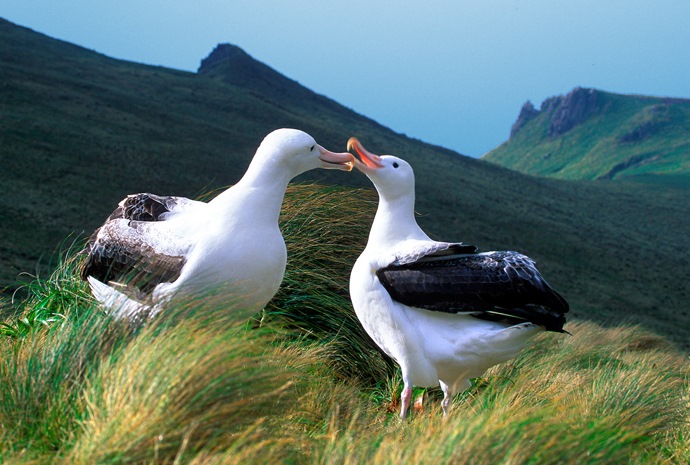
Albatross Species
Wandering albatrosses (Diomedea exulans) range from sub-tropical to Antarctic waters on trips covering up to 10,000 km in 10–20 days. Outside the breeding season, most species migrate long distances, some (like wandering and grey-headed albatrosses) travelling right round the Southern Ocean. Whilst at sea, birds can travel 1000km in a single day, with one grey-headed albatross recorded as circumnavigating Antarctica in just 46 days.
The four species breeding at South Georgia represent all three of the southern hemisphere genera. Only one, the black-browed albatross (Thalassarche melanophris), breeds annually, occurring in large colonies on hillsides, taking 5.5 months from egg laying to chick fledging, feeding its chick on a diet mainly of krill, and to a lesser extent fish and squid.
This is obtained chiefly from the shelf waters around South Georgia and the South Orkney Islands. After breeding, birds migrate to South African waters.
Its close relative, the grey-headed albatross (Thalassarche chrysostoma), breeds only every two years on steep coastal slopes. The light-mantled sooty albatross (Phoebetria palpebrata) is also biennial and breeds solitarily or in very small groups on cliffs. Both these species feed mainly on squid and krill.
The largest of albatrosses is the wandering albatross. This arrives in November to breed in loose colonies on flat grasslands, giving plenty of room for its spectacular displays. It lays eggs in December, chicks hatch in April and are reared throughout the winter (on a diet of fish, squid and carrion) fledging in November and December. Successful parents then take a year off, migrating to feeding areas all around the Soutern Ocean.
Problems facing the Albatross
The populations of all these species at South Georgia are decreasing. The decline of wandering albatrosses is primarily due to their being caught on baited hooks set by tuna longliners in temperate and subtropical waters. The albatrosses try to eat the bait and get dragged under and drowned. Most other species are also killed by longliners, and recently, it has become clear that collisions with trawl net cables are an additional, and potentially worse source of mortality.
Much of the damage is caused by illegal fishing, which accounts for many thousands of deaths each year. However a range of measures are currently in force to try to reduce the number of albatrosses being killed. These include weighting of lines so they sink quickly, retention of offal on board so that birds are not entice to the vessel in the first place, setting lines at night, and setting up bird-scaring or ‘tori’ lines — made up of brightly-coloured streamers to startle seabirds.
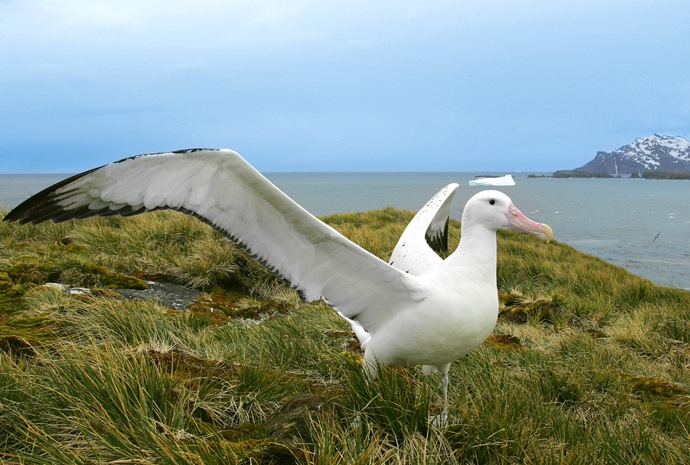
Watch our Antarctica Cruise Video
PlayPetrels
Several species of petrel in a wide ranging group of families can be found in the Antarctic. Most petrels have a skittering, skimming-type flight; hence their name, which means 'Little Peter" for the Apostle who walked on the water with Christ on the Sea of Galilee. All petrel species have dense plumage, webbed feet and deeply grooved and hooked bills. Many species breed in dense colonies on cliffs and steep rocky slopes, some of them 60 miles or more from the open sea on inland nunataks and mountain ranges. Petrels typically have long nostrils, indicating a strong sense of smell, unusual for birds. On human-inhabited islands, cats and rats have severely reduced some populations of diving and burrowing petrels although most petrel species can regurgitate their stomach oil as a defence mechanism against predators.
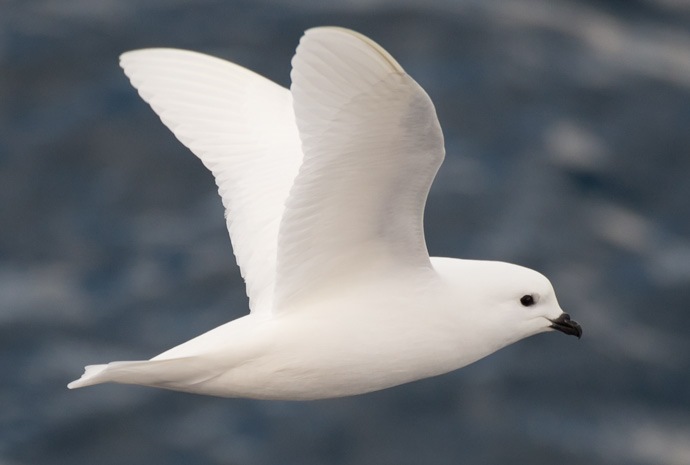
Giant Petrels
Largest of the petrel family, Giant petrels, unlike albatrosses, forage on both land and sea. On land, these Antarctic birds kill other birds as large as King penguins and scavenge in seal colonies. At sea, they eat fish, squid and crustaceans, scavenging dead whales and seabirds, as well. Their carrion-feeding reputation earned them the nickname 'stinkers' from whalers.
Antarctic Petrel
One of the true birds of Antarctica, the Antarctic petrel is a boldly marked dark brown and white petrel, a little smaller than the Antarctic fulmar. They are mostly found in the Ross Sea region. Eggs are laid in November after the adults arrive at their nest sites the previous month. Chicks fledge in March. The rest of the year, the colonies are deserted while the birds stay at sea around the pack ice. They eat krill, fish, and small squid.
Cape Petrel
The Cape petrel, also known as the 'painted one' because of the striking pattern on its back and wings is a dark brown-black and white petrel smaller than the Antarctic Petrel. They breed on cliff ledges. A common 'ship-follower,' the Cape petrel eats just about anything edible thrown overboard. These pigeon sized birds nest on the sea cliffs and in rock crevices and can live for 15 to 20 years.
Great-winged Petrel
The Great-winged petrel is an all dark-brown petrel found in the 'Roaring Forties.' They breed in winter and lay a single egg in May to July in burrows excavated out of vegetated peat slopes. Chicks fledge in November and December, just when the summer-breeding burrowing petrels are getting started. Like most burrowing petrels, Great-wings arrive at their burrows after dark, to reduce their chances of being caught by predatory Antarctic skuas. Great-wings eat primarily squid caught at night.
White-headed Petrel
The White-headed Petrel is a burrowing petrel with dark wings, a white head with a dark eye and a pale body and tail. They breed in summer, laying a single egg in burrows they excavate in the soft peat of tussock grassland. Their diet includes crustaceans, squid, and lantern fish, caught by surface-seizing. White-heads are not rare and their population probably numbers in the low hundred thousands.
Atlantic Petrel
The Atlantic petrel is one of the largest gadfly petrels, recognised by its striking white breast and belly in contrast to the rest of its plumage which is uniformly brown. Population is in the low tens of thousands. They breed in burrows in winter, with chicks being fed in October. They feed mainly on squid and fish.
Wilson's Storm Petrel
The tiny Wilson's storm petrel is one of the world's most abundant seabirds. They are regular ship followers and are associated with whales. They lay a single egg in December in burrows and rock crevices in cliffs, rocky slopes and scree banks. They eat mainly copepods and krill, as well as small squid and fish.
Other species of petrel include: Black-bellied petrels, White-bellied petrels, Grey petrels, Small Grey-backed Storm petrels, and the White-Chinned petrels, White-Faced Storm petrels, Blue petrels, Prions, and Kerguelen petrels
What Our Customers
Say...
Superlatives abound – a truly amazing experience...awesome. Thanks to all for making it such a memorable experience.
We had the time of our lives on board ship...if anybody wants to go to Antarctica, we will certainly advise to go with you.
The best way to describe the entire experience. 1. Top rate service...we would not hesitate to recommend you to others and use you again.
Thank you and your team for arranging what was a fantastic holiday in Argentina...Iguazu falls was exceptional with our guide knowing an awful lot about the falls and the wildlife. Could go on forever, but had better stop.
I’m sure you get plenty of compliments, but I just wanted to follow up by telling you what a great time we had...If we are planning on one of the other regions you serve, we’ll definitely be in touch!
I wanted to drop you a note to say a big “THANK YOU” for all your organizing of my travel arrangements and the holiday itself. Everything flowed perfectly. The holiday was breath-taking and is hard to express in words...
It was even better than I expected, so I am grateful that you made the call (back). I will certainly recommend your services
Thanks again for helping me select the best trip and for all your help with the admin and my questions along the way, it all made for an even better experience.
Thank you for all your help. Great service, very efficient, flexible...We feel looked after when setting off into the unknown. I feel it is my duty to tell fellow travellers and birders/photographers how good you are!
Antarctica Birdwatching Expeditions
Because birds are in profusion at all times, birdwatching is one of the principal activities on most expedition ships. However, one voyage at the end of the season in March positions from Ushuaia to Europe and offers fantastic birdwatching in Antarctica and the South Atlantic around Tristan da Cuhna, St. Helena and Ascension.
View Trips
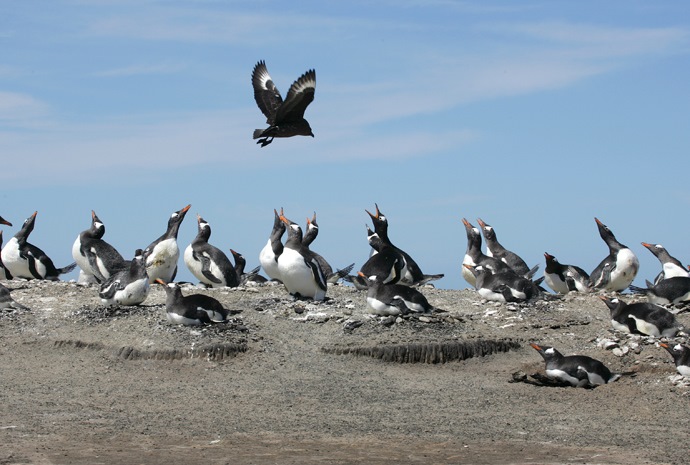
Sign up for our free newsletter
Please enter your email address using the fields below to receive all of the latest news and offers!
Members of The Adventure Travel Trade Association
WILDFOOT are proud to be members of ATTA. The ATTA community put effort towards nurturing, protecting and professionalizing the sustainable development of the adventure travel industry.
